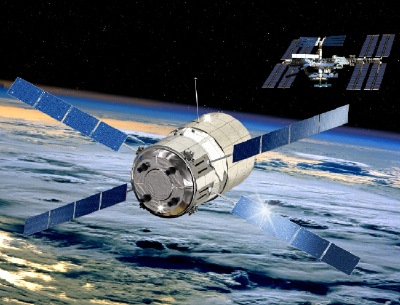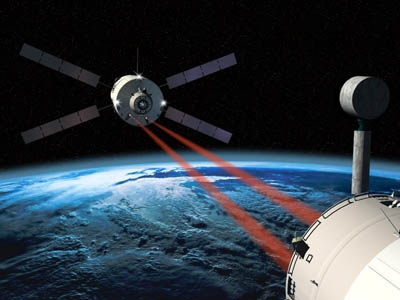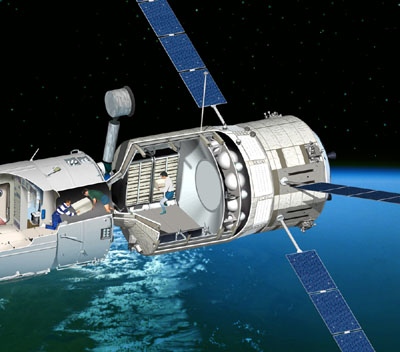| SPACE TODAY ONLINE COVERING SPACE FROM EARTH TO THE EDGE OF THE UNIVERSE | ||||||||||
| COVER | SOLAR SYSTEM | DEEP SPACE | SHUTTLES | STATIONS | ASTRONAUTS | SATELLITES | ROCKETS | HISTORY | GLOBAL LINKS | SEARCH |
International Space Station cargo tug:
ATV to Ferry Supplies and Fuel to the ISS
Autonomous Transfer Vehicle will begin deliveries in 2005
The International Space Station (ISS) depends on regular deliveries of experimental equipment and spare parts as well as fuel, food, air and water for its permanent crew.

ESA artist imagines ATV approaching space station
click to enlarge
Starting in 2005, Europe's Automated Transfer Vehicle (ATV) will become part of the ISS's vital supply line.
About once a year after that, an ATV will haul some 10 tons of cargo from the European Space Agency's Kourou launch site in French Guiana 250 miles up to the station above Earth.
Each ATV has a precision navigation system to guide it along a rendezvous trajectory towards the space station, where it automatically docks with the Russian service module.
An ATV will remain docked with the station for six months. During that time, a some seven tons of station trash will be dumped into the ATV. After six months, the ATV will back out of the dock and drop into the atmosphere where it will burn up.
Next generation space tug. The exterior is an eggshell-coloured cylinder, 34 ft. long and 15 ft. in diameter. The 23-ton ATV has X-shaped solar panels that look like metallic blue wings.
The ATV’s structure is blanketed with an insulating foil layer on top of anti-meteorite panels.
Inside the ATV are two modules, the propulsion spacecraft and the integrated cargo carrier which docks with the ISS.
The 1,600 cubic ft. pressurized section has room for eight racks loaded with up to eight tons of equipment, fuel, food, water and air for the crew.
Water and air. The built-in cargo carrier has tanks containing 1,850 lbs. of drinking water, 1,900 lbs. of fuel for the station’s propulsion system, and 220 lbs. of oxygen and nitrogen for space station air.
Russian docking equipment and rendezvous sensors are in the nose of the cargo section.
As a spacecraft, an ATV navigates with four main engines capable of 110 lbs. of thrust plus 28 smaller thrusters capable of 50 lbs. of thrust for attitude control.
Station boost. After docking at the space station, the ATV can control the ISS's attitude, move the station to avoid debris, and boost the Station's orbit to overcome the effects of atmospheric drag. An orbital boost can use up to 5 tons of propellant.
Although no one will ever be launched in an ATV, astronauts, dressed in ordinary clothing, will be able to enter an ATV to retrieve its contents while it's docked with the ISS.
The ATV pressurized cargo section is based on Italy's Multi-Purpose Logistics Module (MPLM), which has been flown to space inside a shuttle transporting equipment to and from the space station.
Tugboat. Equipped with its own propulsion and navigation systems, the ATV is multifunctional. It combines the robot capabilities of an unmanned vehicle with human safety requirements.
Its mission in space resembles a combined tugboat and river barge.
A typical trip. A typical ATV flight will begin at launch atop an Ariane-5 rocket from the French Guiana equatorial site up to a 160-mile-high orbit .
Piloted remotely by the European Space Agency control center at Toulouse, France, the ATV separates from Ariane and its navigation system is activated.
Thrusters are fired to boost the ATV into a transfer orbit to the ISS.
Arrival at the station. After three days of orbit adjustments, the ATV will come in sight of the ISS at an altitude of 250 miles. When it is about 19 miles behind the station and three miles below it, the ATV will begin to navigate itself into the ISS dock.
During the next two orbits around Earth, the cargo ship's computers begin final approach maneuvers. The ATV closes on the ISS at walking pace. The final docking will be fully automatic.
Watchout! If there are any last-minute problems, either the ATV's computers or the station's crew can take over from the main navigation system and trigger a pre-programmed sequence of anti-collision maneuvers.

Radio signals from ATV to ISS dock
ESA art
The back-up emergency navigation system adds level of safety like an airbag in a car, ESA says.
When the supply ship is securely in the dock, the station crew can enter the ATV cargo section and remove the payload of maintenance supplies, science hardware, and parcels of fresh food, mail, family message tapes and CD-ROMs.
Plumbing. They will connect the ATV's liquid tanks so they can pour their contents into the station's plumbing.
The crew will release manually the supply of fresh air directly into the ISS atmosphere.
For up to six months, the ATV will remain attached to the ISS with its hatch open.
The town dump. During that time, the crew will steadily fill the cargo section with the station's waste.
At intervals of 10 to 45 days, the ATV’s thrusters will be used to boost the station's altitude.
Once its re-supply mission is accomplished, the ATV filled with waste will be closed by the crew and piloted automatically away from the station.
Its thrusters will use their remaining fuel to de-orbit the spacecraft, not at the shallow angle used for the relatively gentle re-entry of manned vehicles, but on a steep flight path to perform a controlled destructive re-entry high above the Pacific Ocean.
Europe's contribution. Providing the ATV and its services is a way for Europe to pay its share in ISS running costs by spending money in the European industry rather than by cash transfers to its international partners.
Depending on the operational lifetime of the International Space Station, ESA will build at least seven ATVs.
Thirty companies from ten European countries, as well as eight other companies from Russia and the United States, share the work under the prime contractor, EADS Launch Vehicles of France.
SOURCE: ESA
Learn more:
| Cover | Rockets | Satellites | Shuttles | Stations | Astronauts | Solar System | Deep Space | History | Global Links |
